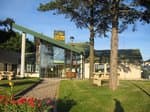Sensitive natural space of the Tournemire amphytheatre
Description
- From the carpark and the Plesiosaur House which are situated opposite the Town Hall, take the righthand road lined with plane trees for 400 m. At the crossroads, turn to the left onto a small road for 500 m.
- Leave the road to your left and follow the path sloping gently towards the gite “la maison de la vigne”.
- Once you have reached the gite, take the descending path and ford the Brias brook (in case of heavy rainfall be careful and turn back).
- Keep walking on the path and reach the hunting lodge which is situated at the corner of the former stadium.
- Take the road for 300 m to walk back down to point 2 and return to the carpark by the route taken when you started the circuit.
- Departure : next to the Town Hall, in front of the Plesiosaur House
- Arrival : next to the Town Hall, in front of the Plesiosaur House
- Towns crossed : Tournemire
Altimetric profile
Recommandations
Box tree moths are active from May to October. During the caterpillar phase, they feed on the leaves of box trees. They crawl down trees and move on long silken threads, although these threads are annoying when hiking they do not pose any health risk
Information desks
Avenue de Lauras, 12250 Roquefort/Soulzon
Situated in the Grands Causses Regional Natural Park, the cheese village of Roquefort stretches on the hillside over the famous scree of the Combalou Rock, in southern Larzac. The village is at an elevation of 630 m and has 700 inhabitants.
OPENING PERIODS:
The Tourist Office is open all year round:
- In July and August, Monday to Saturday: 9.30 to 18.30, Sunday: 10.00 to 17.00.
- April, May, June, September, October; Monday to Saturday: 9.30 to 12.15 & 13.00 to 17.30, closed on Sunday.
- January, February, November, December; Monday to Friday: 9.30 to 12.15 & 13.00 to 17.00, closed on Saturday and Sunday.
Transport
Travel by bus or train: https://lio.laregion.fr/
Carpooling : BlaBlaCar, Rézo Pouce, Mobicoop, Idvroom, LaRoueVerte, Roulez malin
Access and parking
Parking :
Source

Report a problem or an error
If you have found an error on this page or if you have noticed any problems during your hike, please report them to us here:

